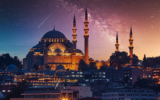
'The regime unleashed its fury on this city for daring to resist,' says Bashar al-Shamtiya
Syrian researcher Bashar al-Shamtiya has documented the historical sites and buildings destroyed by the Baath regime during the Hama massacre in February 1982.
He said the city suffered greatly for resisting the regime's policies.
The 69-year-old Shamtiya has been documenting historical sites and structures that were reduced to rubble during the massacre.
Shamtiya, who converted the upper floor of a historic bathhouse in the center of Hama into a cultural and historical workshop, displays documents and photographs he has gathered in his research at his workshop.He facilitates young researchers and students who visit to learn more about the history and structure of the city.
The Hama native spoke to Anadolu about the massacre, as well as the city's history and his work.
"I have a great interest in photography, and I use it to document Hama's historical sites," he said.
Explaining that Hama has hosted many civilizations throughout history, he stated: "There are many historical structures in Hama. These structures are a testament to Hama's deep-rooted history."
Emphasizing that most of the structures were destroyed in the massacre, he said, "In 1982, the historic al-Kaylaniyya neighborhood was wiped out. The historic districts of al-Zanbakiya, Shajra and al-Tawafraf were devastated. They bombed the Grand Mosque. The old church and ancient mosques in the Madinah district were reduced to rubble. The museum was destroyed."
- 'They transported the bodies to designated locations using heavy machinery'
Shamtiya noted that the people of Hama had been opposing the Baath regime since the 1960s.
"The regime unleashed its fury on this city for daring to resist," he said, emphasizing the devastating toll Hama paid.
"In 1982, Hama had around 250,000 residents," he explained. "Approximately 40,000 people were killed in the massacre, while 60,000 others were detained and never heard from again. Among them was my own brother, we still have no idea what happened to him."
Reflecting on his loss, he added, "I lost at least 20 relatives and close friends in that massacre 43 years ago."
Shamtiya said he has meticulously documented their names but lamented that "we do not know where the victims were buried." Streets were littered with bodies, and soldiers arrived "collecting them with bulldozers" before they "transported the bodies to designated locations using heavy machinery."
"A city was erased from the map, and its people were massacred," he stated, insisting that "no other event in history compares to this atrocity."
The regime deliberately and "systematically targeted mosques," and "struck all the sacred sites in the city."
Even decades later, he maintained that "those responsible must be held accountable."
- Hama Massacre
Forty-three years ago, Syria's ousted Baath regime committed one of the country's worst atrocities with the 1982 Hama Massacre, killing tens of thousands and leaving thousands more missing.
Having seized power in a 1963 coup and then overthrown in December 2024, the regime carried out its deadliest crackdown in Hama, a city known for its strong opposition to the government.
During then-President Hafez al-Assad's rule, regime forces besieged Hama at the end of January 1982 under the pretext of suppressing an uprising by the Muslim Brotherhood. Artillery units and tanks were positioned on high ground and hills surrounding the city.
The massacre began Feb. 2 and was led by Rifaat al-Assad. Residential areas were first bombed from the air, followed by intense artillery shelling.
According to estimates by the Syrian Network for Human Rights, around 40,000 civilians were massacred in Hama through attacks and mass executions by regime forces. The locations of their graves remain unknown.
More than 17,000 civilians detained in house raids were never heard from again. Their families believe they were taken to the Tadmor Prison in Homs and executed.
Syrian Network for Human Rights data shows entire neighborhoods, including al-Sahhane, al-Kaylaniyya, al-Asida, al-Shimaliyya, al-Zenbakiya and Bayn Hayrin \ destroyed, while 80% of al-Barudiyya, al-Bashuriyya, al-Amiriyya and Manah were devastated.
Along with the attacks, many historical sites, particularly in al-Kaylaniyya, were severely damaged. A total of 88 mosques and three churches were destroyed or severely damaged. Mosques, schools and factories were converted into detention centers.
Hello, the comments you share on our site are a valuable resource for other users. Please respect other users and different opinions. Do not use rude, offensive, derogatory, or discriminatory language.
The floor is all yours.








